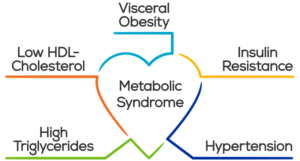Androgenetic alopecia, commonly known as male or female pattern baldness is a form of hair loss that is caused by genetic and hormonal factors. Traditionally thought to be just a cosmetic disorder, recent research has shown that baldness is more than just about hair- it is about heart too. Patients with baldness, particularly young patients and those with severe baldness may be predisposed to what is known as metabolic syndrome which can lead to heart issues. This blog explains the relation between hairloss and heart.
What is Metabolic Syndrome?
Metabolic syndrome is a group of health conditions that often occur together including increase in fat around the waist, high blood pressure, high blood sugar levels, increased cholesterol levels.

Are these related?
Yes. Research has shown that there may be a link between androgenetic alopecia and metabolic syndrome. Other factors such as family history, lifestyle and diet can also contribute to the development of metabolic syndrome. All these can affect hair growth cycle and result in hair loss.
What are the risks associated with these two?
Individuals with this type of hair loss may have an increased risk of developing heart diseases, stroke and type 2 diabetes.
It also appears that there is a relationship between the degree of hair loss and the risk of heart disease, meaning, the greater the severity of hair loss, the greater the risk of heart disease.
Cause of Metabolic Syndrome
- High insulin levels secondary to resistance to action of insulin in metabolic syndrome leads to excess production of androgen hormone by adrenal glands. This increased androgen hormone is involved in male or female pattern hair baldness.
- Since androgen receptors are also expressed in pancreatic and liver cells, high levels of this hormone can result in increased insulin levels, thus forming a vicious cycle.
- On the other hand, in diabetes, there is thickening of blood vessels making them narrow. Thus narrow blood vessels means decreased blood and oxygen supply to hair follicles.
- This increased insulin level is also a risk factor for developing heart diseases.
- The increased androgen hormone also leads to decreased blood supply, oxygen and nutrient insufficiency which are required for growth of hair baldness.
It also acts on receptors in blood vessels causing increased blood pressure
Prevention of Metabolic Syndrome
Screening of individuals for metabolic syndrome with this pattern of hair loss is to be done at the earliest. This includes blood pressure monitoring, investigating for cholesterol levels, blood sugar levels. One should also report to doctor for further evaluation if they have male or female pattern baldness, increased waist circumference, increased thirst and urination.
How can it be managed?
- Treatment of the hair loss at the earliest
Lifestyle changes is to be undertaken:
30 minutes of physical activity daily
Maintaining proper weight
Healthy diet, limiting intake of sugar, salt and saturated fats
Avoiding smoking
Avoiding stress
If you are concerned about either of these conditions, it’s best to consult your doctor for a proper evaluation and appropriate management.



